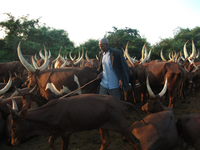
Lawrence Kayinamura and his family only moved into a real house in 1995. Before that, they were nomads, herding cattle through the broad plains of Ankole, living on the milk, blood and meat of their herds, erecting small huts of sticks and thatch for shelter, independent and self sufficient, even prosperous. It was the wealth of his cattle that let Lawrence make the switch from nomad to homeowner. He traded part of his herd for a piece of land in Rakai district, just outside his Ankole homeland, then settled into a different routine, taking his cows out every day to his 60 acres of grass and bush, with a bore hole well for watering, and some stables and enclosures to keep the herd safe at night.
I was there one day as dawn broke on the sleeping herd. Geoffrey, the herd boy, scooted around from cow to cow, taking the morning’s milk, which nourishes the humans in this family, as well as the calves. Lawrence walked among the drowsy cattle looking for any signs of disease or discomfort. He had lost 12 cows recently to malaria, and didn’t want to lose any more. The heat of the sun here, just a few degrees south of the Equator, was hard on the cattle too. In half an hour most of the herd was on their feet, anticipating the morning foray into the wild pasture outside the enclosure. The huge placid beasts were pretty quiet, with only occasional lowing. When they moved together, their huge horns clattered softly against each others, like soft, off-beat maracas.
It was the morning routine.
I was visiting Lawrence's farm near Mutukula on the Tanzanian border with my friends Mathias and Jovia Tusiime. Lawrence is Jovia's dad, and she was raised in the Ankole cattle culture with her 15 brothers and sisters.
The Ankole used to bleed their animals and drink the blood, or cook it into a solid cake, (tastes something like liver, Mathias said). But with the increased use of vaccines and antibiotics, it’s no longer safe for people to ingest cows blood. Milk and meat are still ok, though. Lawrence and Edisa raised 15 children while they tended the cattle, though not all of them survived childhood, and two of the boys did not survive adulthood. Some of the boys went to school. But Jovia, Mathias’ wife, left school after primary 3, because at the time, her family lived pretty far outside the cash economy, they couldn’t afford school fees, and they never stayed in one place long enough.
Now, Lawrence is 73, and I think he’s glad he doesn’t have to wander endlessly with his cows. But he built a little hut across the highway from his house, and he stays there with the cattle when he has to move the herd to the pastures across the road.
The house is modern, with standard Ugandan architecture; metal roof, walls built from bricks made on site. But it still doesn’t have electricity, despite high tension power lines passing 100 feet away. There’s no running water either. When I asked for a glass of water, I was offered milk. The milk is delicious. Thick and creamy, usually served hot.
More photos from my visit to Lawrence and his family in my facebook album.
